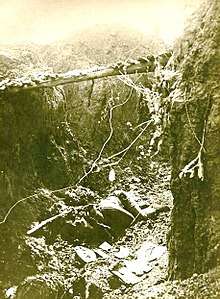Battle of Gnila Lipa
The Battle of Gnila Lipa took place early in the World War I on 29–30 August 1914, when the Imperial Russian Army invaded Galicia and engaged the defending Austro-Hungarian Army. It was part of a larger series of battles known collectively as the Battle of Galicia. The battle ended in a defeat of the Austro-Hungarian forces.
| Battle of Gnila Lipa | |||||||
|---|---|---|---|---|---|---|---|
| Part of the Eastern Front during World War I | |||||||
 | |||||||
| |||||||
| Belligerents | |||||||
|
|
| ||||||
| Commanders and leaders | |||||||
|
|
| ||||||
| Units involved | |||||||
|
|
| ||||||
| Strength | |||||||
|
385,000 men +:[1] 336 infantry bataillons 164 cavalry squadrons 1.214 guns |
322,000 men+:[1] 282 infantry bataillons 133 cavalry squadrons 718 guns | ||||||
| Casualties and losses | |||||||
| Light |
20,000 70 guns | ||||||
Location
The battle is named after a river in Western Ukraine, an historical region of Galicia. It is a tributary of Dniester, and is also called the Hnyla Lypa (Polish: Gnila Lipa).
Overview
The initial Austro-Hungarian offensive against the invaders in the north of Galicia was a success, gaining victories in the Battles of Kraśnik and Battle of Komarów, in part because the Russian Army had expected the main assault to come further the south near Lemberg and had concentrated their forces there.
However, when the Austro-Hungarian Third Army under Rudolf von Brudermann advanced on August 26 with its three Army Corps (XII, III and XI), it encountered a large Russian army consisting of the eight Corps of the Third and Eighth Armies. Fighting on the Zlota Lipa River, the outnumbered Austrians were soundly defeated, and by the end of the day they were in headlong retreat. Army group Kövess also suffered a defeat near Brzezny, though it managed to escape despite being nearly surrounded by the Eighth Army of Aleksei Brusilov.
Franz Conrad von Hötzendorf ordered a new line of defence to be established on the Gnila Lipa River. The Russians required two days to regroup their troops, which gave the retreating Austrians time enough to recover. Hötzendorf still hoped he could maintain the initiative, and he ordered the Austrian 3rd Corps to attack the Russians near Peremyshliany. Unfortunately for him, the Russian forces there now numbered 292 battalions with 1,304 artillery pieces, against the Austrian 3rd Corps' 115 battalions and just 376 field guns. The Austrian attack was easily turned back, and a massive Russian counterattack shattered the Austrian lines. Kövess also failed to stop a superior Russian force near Rohatyn. The Austrian forces retreated to Lemberg (Lvov), having suffered 20,000 casualties and lost 70 of their cannons.[2] The fortress city of Lemberg itself fell to the Russians on 3 September. The Austrian Second Army of Eduard von Böhm-Ermolli was quickly transferred from the Serbian front, and its VIIth Corps arrived in time to prevent a complete Austrian collapse in Galicia.
Sources
- Buttar, P. (2014). Collision of Empires: The War on the Eastern Front in 1914. Osprey Publishing. ISBN 978-1472813183.
- J. Rickard: Battle of Gnila Lipa, 26-30 August 1914.
Notes
- Österreichisches Bundesministerium für Heereswesen vom Kriegsarchiv. "Österreich-Ungarns letzter Krieg 1914-1918. Erster Band": p.249
- Buttar 2014, p. 259.